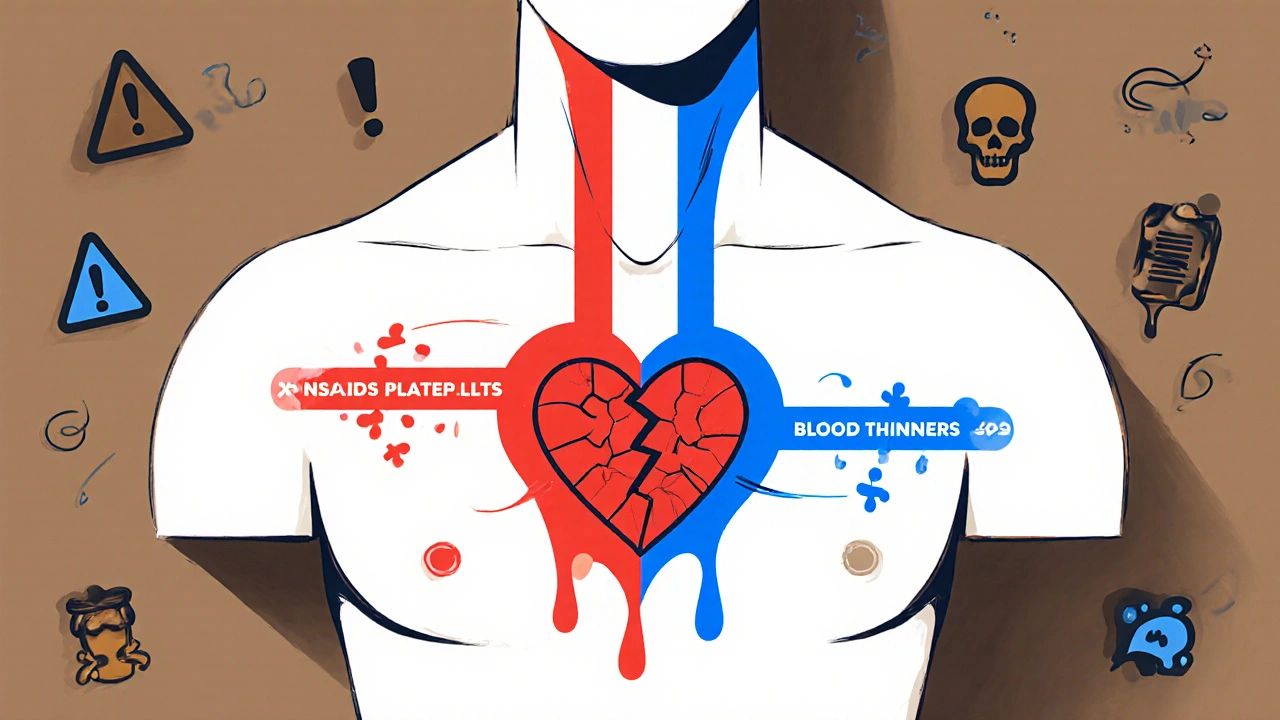
Many people take NSAIDs like ibuprofen or naproxen for back pain, arthritis, or headaches without realizing they could be putting themselves at serious risk-if they’re also on a blood thinner. This combination isn’t just a minor concern. It’s one of the most common and dangerous drug interactions in older adults, and it’s happening far more often than doctors expect.
Why This Combination Is So Risky
NSAIDs and blood thinners don’t just work differently-they attack your body’s ability to stop bleeding from two sides. NSAIDs block enzymes called COX-1 and COX-2. That’s how they reduce pain and swelling, but it also means your platelets can’t stick together properly to form clots. Meanwhile, blood thinners like warfarin, apixaban, or rivaroxaban slow down the proteins your blood needs to clot. When you put them together, your body loses both its first and second lines of defense against bleeding.The result? A much higher chance of internal bleeding. Studies show this combination makes serious bleeding more than twice as likely. One 2024 study from Denmark found people on blood thinners who took naproxen had over four times the risk of bleeding compared to those who didn’t take NSAIDs. Even ibuprofen, often thought of as "milder," still raised the risk by nearly 80%.
Where the Bleeding Happens
This isn’t just about getting a cut that won’t stop bleeding. The real danger is internal bleeding you might not notice until it’s too late.- Gastrointestinal bleeding: This is the most common. NSAIDs irritate the stomach lining, and blood thinners prevent the clotting needed to seal those tiny ulcers. Together, they can cause life-threatening stomach or intestinal bleeds. Risk goes up by over 120%.
- Intracranial hemorrhage: Bleeding in the brain is rare but deadly. This combination triples the risk.
- Urinary tract and lung bleeding: Less talked about, but still dangerous. Blood in urine or coughing up blood can be signs you’re bleeding internally.
- Anemia: Slow, ongoing bleeding from the gut can lead to iron deficiency without obvious symptoms-fatigue, dizziness, shortness of breath. Risk increases nearly threefold.
These aren’t theoretical risks. In the U.S. alone, over 87,000 emergency room visits each year are tied to this interaction. About 24,000 people end up hospitalized. The cost? More than $1.2 billion annually.
Not All Blood Thinners Are the Same
The danger varies depending on what kind of blood thinner you’re taking. Warfarin, the older type, interacts more strongly with NSAIDs. When combined, it can cause your INR (a blood test that measures clotting time) to spike by nearly 1 point-enough to push you into dangerous territory.Newer blood thinners-called DOACs (like apixaban, rivaroxaban, dabigatran)-don’t need regular blood tests, but they’re still risky with NSAIDs. While the overall bleeding risk is lower than with warfarin, it’s still doubled or tripled when NSAIDs are added.
One surprising finding: Celecoxib (a COX-2 inhibitor) causes less stomach bleeding than naproxen or ibuprofen. But it’s still not safe. It doesn’t protect you from brain or kidney bleeds. So even if your stomach feels fine, you’re still at risk elsewhere.
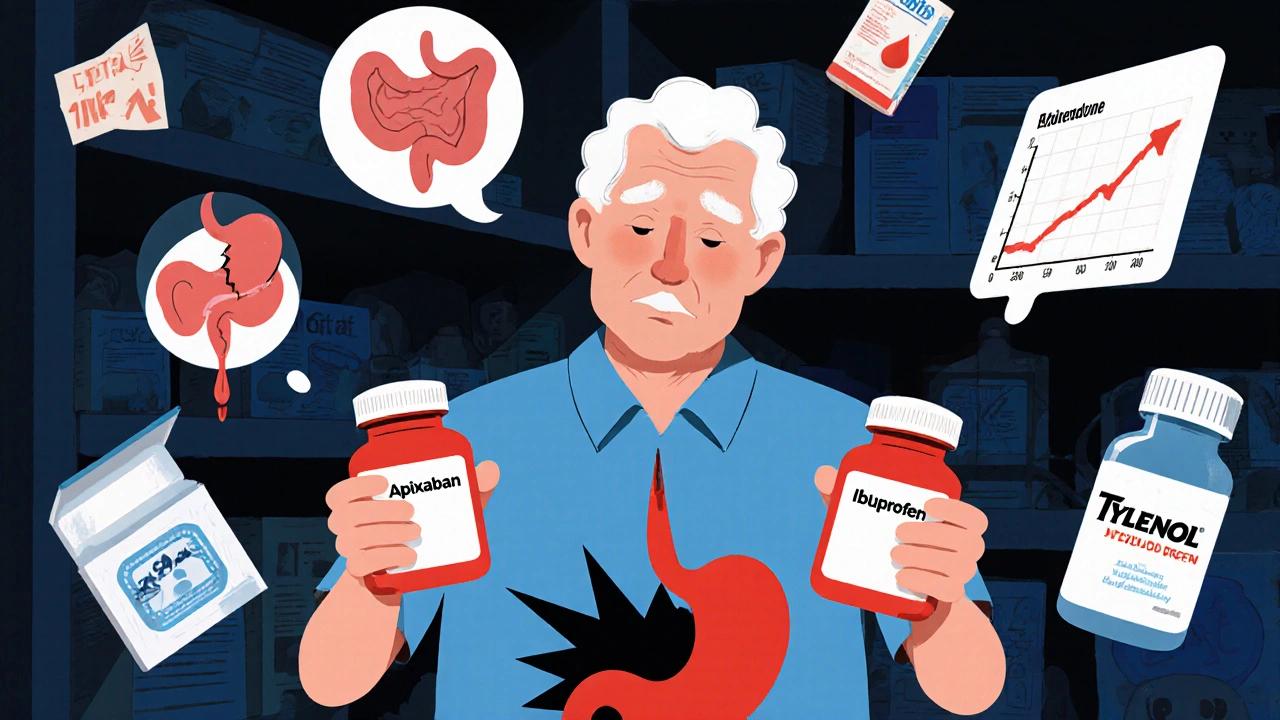
What About Acetaminophen?
There’s one pain reliever that doesn’t raise bleeding risk: acetaminophen (Tylenol). Multiple studies confirm it’s safe to use with warfarin and DOACs when taken at recommended doses (up to 4,000 mg per day).But it’s not a perfect solution. High doses can damage your liver, especially if you drink alcohol, have fatty liver disease, or take other medications that affect the liver. For people with healthy livers, it’s the best option. For others, it’s a trade-off.
And here’s the catch: many people don’t realize how much acetaminophen they’re already taking. Cold and flu medicines, sleep aids, and prescription painkillers often contain it. Taking extra Tylenol on top of these can easily push you over the safe limit.
What Patients Are Actually Doing
Despite all the warnings, a lot of people keep using NSAIDs. On Reddit’s anticoagulant community, 62% of over 1,400 respondents admitted to taking ibuprofen or naproxen while on blood thinners. Nearly 40% had already experienced bleeding-nosebleeds, bruising, or worse.Why? Pain. Many say their arthritis pain is so bad they can’t walk, sleep, or do simple tasks. When doctors tell them to stop NSAIDs, they feel like they’re being told to live in constant discomfort. A 2023 AARP survey found 37% of older adults with arthritis reported reduced mobility after stopping NSAIDs.
Another big issue? Hidden NSAIDs. People go to the dentist for a tooth extraction and get prescribed ibuprofen. They buy a cold medicine that says "pain relief" on the label-unaware it contains naproxen. Or they grab an OTC painkiller from the shelf without telling their doctor.
One common failure case: a 72-year-old on apixaban takes two 200 mg ibuprofen tablets for a headache before bed. The next morning, they wake up with blood in their urine. They go to the ER. By then, their hemoglobin has dropped 3 points. They need a blood transfusion.
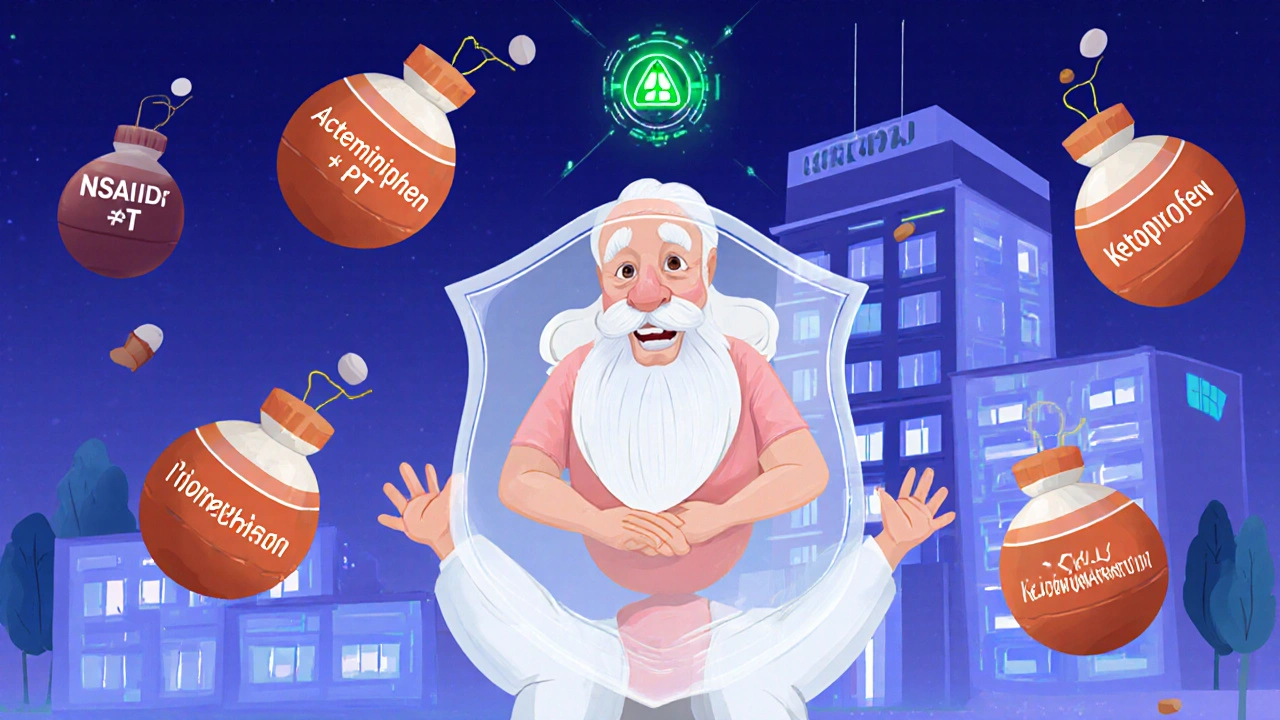
What Doctors Should Do
The American Heart Association, American College of Cardiology, and European Society of Cardiology all agree: avoid NSAIDs if you’re on a blood thinner. But in practice, it’s not that simple.Guidelines say if you absolutely must use an NSAID:
- Use the lowest dose possible (ibuprofen no more than 400 mg per day).
- Take it for the shortest time-no longer than three days.
- Always take a proton pump inhibitor (PPI) like pantoprazole 80 mg daily to protect your stomach.
- If you’re on warfarin, get your INR checked weekly during that time.
But here’s the problem: only 38% of U.S. hospitals have electronic systems that block doctors from prescribing NSAIDs to patients on blood thinners. And only 29% of patients remember the warning three months after being told.
Pharmacists are often the last line of defense. A 2022 study found 42% of patients needed a pharmacist to explain the risk before they stopped using NSAIDs.
What You Can Do
If you’re on a blood thinner and you’re in pain:- Switch to acetaminophen-if your liver is healthy.
- Ask your doctor about physical therapy. For arthritis, movement often helps more than pills.
- Check every medicine label. Look for "ibuprofen," "naproxen," "ketoprofen," or "indomethacin." Even "PM" versions of sleep aids can contain NSAIDs.
- Tell every doctor, dentist, and pharmacist you’re on a blood thinner-even if they don’t ask.
- Don’t assume OTC means safe. Just because you can buy it without a prescription doesn’t mean it’s safe with your other meds.
One patient in Cleveland Clinic’s 2023 study switched from naproxen to acetaminophen and physical therapy. After four weeks, 68% of patients reported their pain was under control. They didn’t need the NSAID anymore.
The Future Is Changing
Health systems are starting to act. Some hospitals now use AI tools that flag dangerous drug combinations before the prescription is even filled. Early results show 85% accuracy in catching NSAID-blood thinner pairs.The American Heart Association is expected to release new guidelines in early 2025 that will likely make the warnings even stronger. One study found this combination increases the risk of death by 80% in people on blood thinners.
By 2030, experts predict NSAID prescriptions for patients on blood thinners will drop by half-thanks to better alerts, patient education, and more accessible alternatives.
But until then, the risk is real. And it’s preventable.
Can I take ibuprofen with warfarin?
No. Combining ibuprofen with warfarin significantly increases your risk of serious bleeding, especially in the stomach and brain. Warfarin already makes your blood take longer to clot, and ibuprofen reduces your platelets’ ability to form clots. This combination can cause your INR to rise dangerously high. If you need pain relief, switch to acetaminophen (Tylenol) instead.
Is Tylenol safe with blood thinners?
Yes, acetaminophen (Tylenol) is generally safe to use with all types of blood thinners, including warfarin, apixaban, rivaroxaban, and dabigatran. It doesn’t affect platelets or clotting factors. But don’t exceed 4,000 mg per day, and avoid alcohol. High doses can damage your liver, especially if you already have liver disease.
What if I accidentally took ibuprofen while on a blood thinner?
If you took one or two doses of ibuprofen by accident, don’t panic-but don’t ignore it either. Monitor for signs of bleeding: unusual bruising, dark or tarry stools, blood in urine, dizziness, or headaches. If you notice any of these, contact your doctor immediately. Going forward, avoid NSAIDs completely unless your doctor gives you a clear, written plan with protective measures like a stomach pill (PPI).
Are there any NSAIDs that are safe with blood thinners?
No NSAID is truly safe with blood thinners. Even celecoxib (a COX-2 inhibitor), which causes less stomach irritation, still increases the risk of bleeding in the brain, kidneys, and elsewhere. The only exception is using the lowest possible dose for the shortest possible time (under 3 days) while also taking a stomach-protecting medication. But even then, it’s not recommended unless absolutely necessary.
Why do some doctors still prescribe NSAIDs with blood thinners?
Some doctors may prescribe NSAIDs because they assume the patient’s pain is too severe to manage without them-or they’re unaware of the full risk. Others may rely on patients to report their OTC use. But current guidelines from major heart and medical societies clearly state NSAIDs should be avoided. If your doctor prescribes one, ask why and request alternatives like acetaminophen, physical therapy, or topical pain relievers.
Can I use topical NSAIDs like Voltaren gel instead?
Topical NSAIDs like diclofenac gel (Voltaren) are much safer than oral forms because very little of the drug enters your bloodstream. Studies show they don’t significantly increase bleeding risk with blood thinners. They’re a good option for localized pain, like knee or shoulder arthritis. But avoid applying them over large areas or for long periods without checking with your doctor.

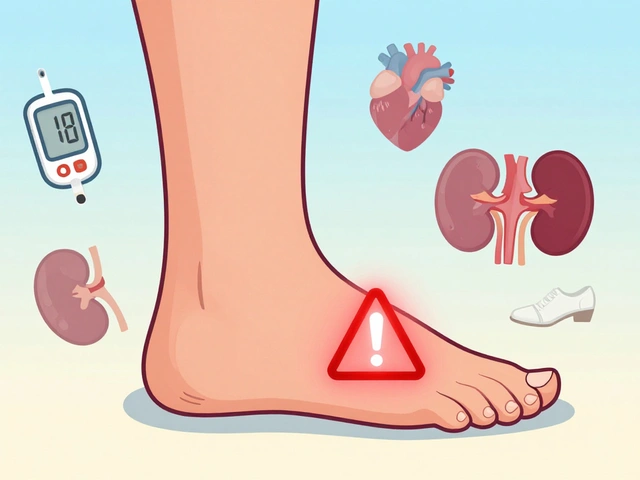
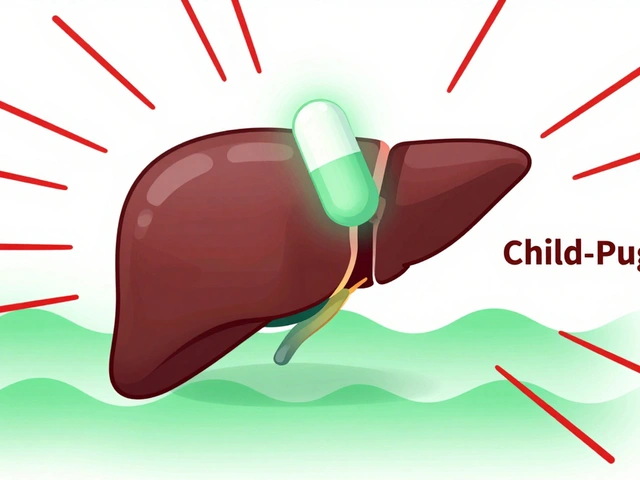
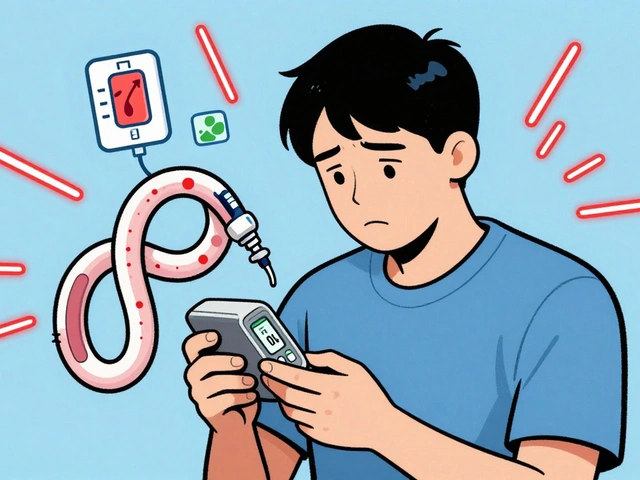
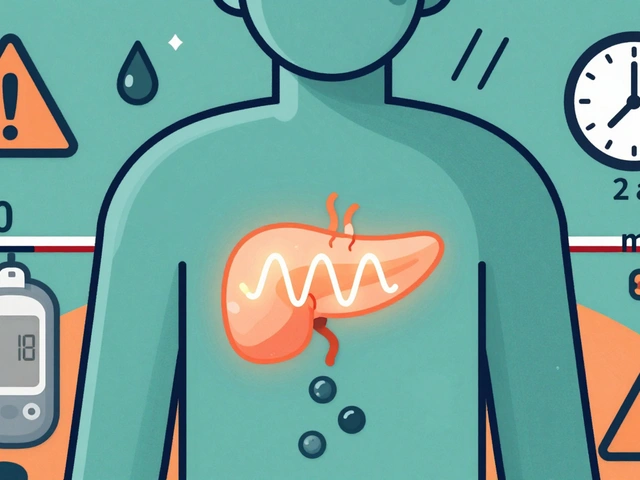
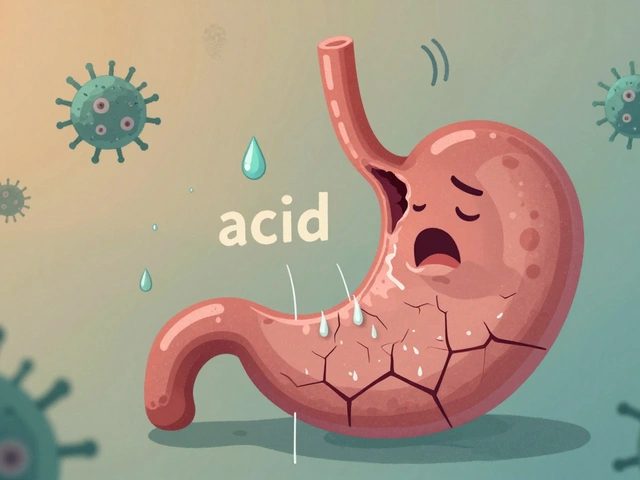
10 Comments
Stop taking NSAIDs if you're on a blood thinner. Period. I used to take ibuprofen for my knees until I started bleeding internally. Now I use Tylenol and physical therapy. My pain is manageable and I'm not in the ER. Your body isn't a suggestion box.
Y’all are overreacting 😩 I took ibuprofen with warfarin for 3 years and I’m fine. My dog even lived longer than my last relationship. 🐶💔
MaKayla, you’re lucky. Really. Most people who do what you did end up in the ICU with a GI bleed. Don’t be that guy who says ‘it worked for me’ while ignoring the 87,000 ER visits a year. I’ve seen it. It’s not pretty. Tylenol is your friend. Use it.
Topical NSAIDs work. No bleeding. Just pain relief.
People are so careless. They think OTC means harmless. They don’t read labels. They don’t tell their doctors. They don’t care until they’re vomiting blood. This is preventable. And yet, here we are.
Let’s break this down clinically: NSAIDs inhibit COX-1 → reduce platelet aggregation → synergize with anticoagulants → increased INR and microvascular bleeding risk. DOACs don’t require monitoring, but their pharmacokinetics still overlap with NSAID-induced gastric mucosal damage. Acetaminophen is the gold standard for analgesia in this cohort-no CYP interaction, no platelet effect. Topical diclofenac has <1% systemic absorption-clinically negligible. PPIs reduce GI risk but don’t eliminate intracranial or renal hemorrhage. Bottom line: avoid oral NSAIDs unless absolutely necessary, and even then, with PPI + INR monitoring.
My grandma switched to Tylenol and started walking again without painkillers… she’s 84 and now does yoga 🙌 I didn’t believe it until I saw it. Pain isn’t a life sentence. Movement is medicine. And so is listening to your body. Stop ignoring the warning signs. You’re not invincible.
Doctors are just selling pills. They don’t care if you bleed. They get paid either way. Tylenol? Too cheap. PT? No profit. This whole thing is a scam.
im so glad i found this. i didnt realize my cold med had naproxen in it. i was on apixaban and woke up with blood in my pee. i thought it was a UTI. i went to the er and they told me it was the combo. i feel so stupid. but now i check every label. thanks for sharing. i think i might try the gel too.
You think this is bad? Wait until you find out NSAIDs cause kidney failure in 1 in 20 people over 65 on blood thinners. No one talks about that. The FDA doesn’t warn you. The ads say ‘safe for most.’ Safe for most? No. Safe for none. This is a slow murder disguised as pain relief.